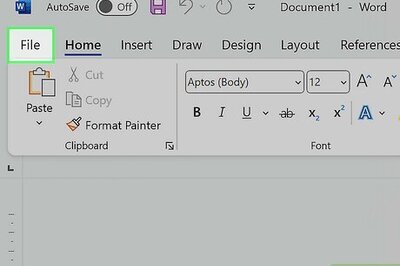
views
Planning for retirement is essential for ensuring financial security in your later years. In India, several government-backed and regulated schemes are designed specifically to help individuals save for retirement. This article explores key retirement schemes that play a crucial role in financial planning.
1. Employee Provident Fund (EPF)
The Employee Provident Fund (EPF) is a retirement savings scheme for salaried employees. Both the employee and employer contribute to the fund, which earns a fixed interest rate set by the government.
Tax Benefits: Contributions are tax-deductible under Section 80C, and the interest earned is tax-exempt.
Employer Contribution: Employers match the employee’s contribution, effectively doubling the savings.
Guaranteed Returns: The EPF offers a fixed interest rate, ensuring steady growth of the retirement corpus.
Limited Flexibility: The EPF is mandatory for salaried employees earning up to ₹15,000 per month, with limited options to adjust contributions.
Withdrawals: Full withdrawal is only permitted under specific conditions like retirement or unemployment.
2. Public Provident Fund (PPF)
The Public Provident Fund (PPF) is a long-term savings scheme with a 15-year lock-in period, offering tax-free returns and government-backed security.
Tax Efficiency: Contributions qualify for tax deductions under Section 80C, and the interest earned is tax-free.
Safety: Backed by the government, making it a safe investment.
Compounding: The long lock-in period allows for significant growth through compounding.
Lock-In Period: PPF has a 15-year lock-in period, with limited liquidity. Partial withdrawals are allowed after the sixth year.
Fixed Returns: The interest rate is fixed by the government and may be lower than market-linked instruments.
3. National Pension System (NPS)
The National Pension System (NPS) is a market-linked retirement savings scheme open to all Indian citizens aged 18-70 years. It allows for flexible investment in equities, corporate bonds, and government securities.
Tax Benefits: Contributions are eligible for tax deductions under Section 80C and an additional ₹50,000 under Section 80CCD(1B).
Flexibility: Subscribers can choose their investment mix based on risk tolerance.
Annuity Purchase: Ensures a steady post-retirement income.
Market Risk: Returns depend on the performance of underlying assets, with no guaranteed returns.
Mandatory Annuity: At least 40% of the corpus must be invested in an annuity, which might offer lower returns.
4. Atal Pension Yojana (APY)
The Atal Pension Yojana (APY) is a government-backed pension scheme targeting workers in the unorganized sector. It guarantees a fixed monthly pension ranging from ₹1,000 to ₹5,000.
Guaranteed Pension: Provides a predictable and stable income post-retirement.
Government-Backed: Ensures the safety of investment.
Auto Debit: Easy to maintain regular contributions.
Lower Pension Amount: The maximum pension is ₹5,000 per month, which may not suffice for all retirement needs.
Age Limit: Available only to individuals aged 18-40 years, with the pension starting at 60.
5. Senior Citizens Savings Scheme (SCSS)
The Senior Citizens Savings Scheme (SCSS) is designed for individuals aged 60 and above. It offers a fixed interest rate with the option of receiving regular interest payouts.
High Interest Rate: Offers one of the highest interest rates among fixed-income instruments.
Tax Benefits: Contributions are eligible for tax deductions under Section 80C.
Quarterly Payouts: Provides regular income to retirees.
Tax on Interest: Interest earned is taxable.
Investment Limit: Maximum investment allowed is ₹15 lakh, which might limit its suitability for those with larger retirement savings.
6. Voluntary Provident Fund (VPF)
The Voluntary Provident Fund (VPF) is an extension of the EPF, where employees can voluntarily contribute more than the mandatory 12% of their basic salary.
High Returns: Earns the same interest rate as EPF, generally higher than other fixed-income instruments.
Tax Efficiency: Contributions are tax-deductible under Section 80C, and the interest is tax-free.
Compounding: Contributions and interest accumulate, significantly growing the retirement corpus.
Limited Liquidity: Withdrawals are restricted, and full withdrawal is allowed only at retirement or under certain conditions.
No Employer Contribution: There is no matching contribution from the employer for the voluntary portion.
Which One Should You Choose?
“When planning for retirement in India, it’s crucial to choose the right mix of schemes based on your financial goals, risk appetite, and time horizon. Each of these retirement schemes offers unique benefits and considerations, making it important to understand them fully before making a decision. By diversifying your investments across these instruments, you can build a robust retirement corpus that ensures financial security and peace of mind in your later years. Regularly reviewing and adjusting your retirement plan is also key to staying on track with your long-term financial objectives,” said a tax expert.




















Comments
0 comment